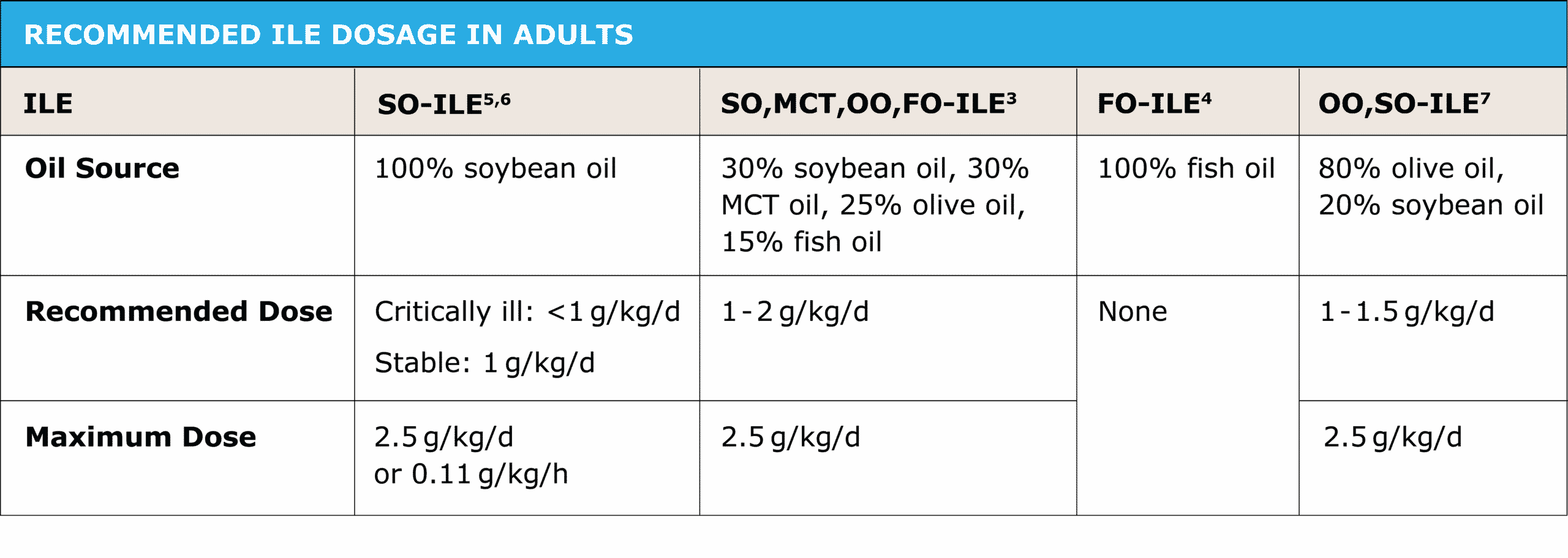

The lowdown on lipid dosing
Lipid injectable emulsions (ILEs) are fats given intravenously to provide energy and fatty acids for patients who require parenteral nutrition (PN).1,2 There are various ILE products available on the U.S. market today, including single-oil formulations and multi-oil formulations.
Single-oil ILEs contain either soybean oil (SO) or fish oil (FO).1,2 The two-oil ILE product contains SO and olive oil (OO) while the four-oil ILE product contains SO, medium-chain triglycerides (MCT), OO, and FO.1,2 Because the composition of each ILE is different, it’s important for clinicians to understand these differences in order to prescribe a safe and appropriate dose for their patients. Now, let’s take a look at recommended dosing for these complex ILE formulations.
What is appropriate lipid dosing anyway?
For patients on PN, dosing needs differ in pediatric, neonatal, and adult populations. Appropriate dosing depends on a number of factors that the prescribing physician must consider. The recommended ILE dosage is based on the patient’s energy needs, age, weight, tolerance, clinical status, additional energy sources, and the ability to metabolize and eliminate lipids.3,4
“Unless contraindicated or in critically ill [adult] patients receiving lipid calories from propofol, I’m a firm believer in daily administration of lipid injectable emulsions (ILEs). This has always been my practice during my career in nutrition support. It’s exciting to have some newer ILEs in the U.S. market, especially when prescribing PN in the critically ill or long-term [adult] patient.”
Phil Ayers, PharmD, BCNSP, FMSHP, FASHP
Once the indication for PN and an ILE has been confirmed, the ILE dose should be ordered as the amount per day.1,2 It’s important to note that a dosage decrease may be required in patients who are receiving other lipid-containing preparations to avoid adverse effects.1

FO-ILE, fish oil ILE—Omegaven (Fresenius Kabi); ILE, lipid injectable emulsion; OO, SO-ILE, olive oil, soybean oil ILE—Clinolipid® (Baxter Healthcare Corporation); SO, MCT, OO, FO-ILE, soybean oil, medium-chain triglycerides, olive oil, fish oil ILE—SMOFlipid® (Fresenius Kabi); SO-ILE, soybean oil ILE—Intralipid® (Baxter Healthcare Corporation), Nutrilipid (B. Braun Medical, Inc.)
Chart adapted from Mirtallo JM, et al. Nutr Clin Pract. 2020;35(5):769-782.
The SO-ILE dose is based on ASPEN recommendations, whereas the dose of the other ILE products for use in adults is from the manufacturer’s information.
The consideration of daily lipid dosing
“The administration of intravenous lipid emulsions should be generally a part of PN.”8 Unfortunately, persistent shortages of PN components witnessed in the last decade have led to a tendency of practitioners to provide less than adequate dosing, which can lead to nutrient deficiencies and impaired growth and healing.9 Recent inventory for lipids has increased and is now fully stocked enabling clinicians to resume the recommended dosing practices accordingly.
“In my clinical experience, the use of daily ILE allows the clinician to reduce the amount of dextrose needed to provide adequate calories and assists in glycemic control. The literature supports that optimal glycemic control leads to positive outcomes such as a reduction in infections and length of stay.”
Phil Ayers, PharmD, BCNSP, FMSHP, FASHP
As pioneers in clinical nutrition, our innovations nourish at every age and stage of life, from hospital to home. We’re proud to be the U.S. market leader in ILEs,10 and we encourage you to contact your PN Sales Specialist about any questions you may have about ILE products. In the meantime, explore our comprehensive portfolio of innovations that nourish at: www.FreseniusKabiNutrition.com/pn-portfolio